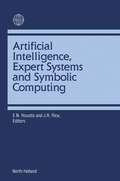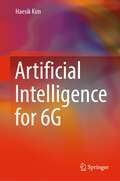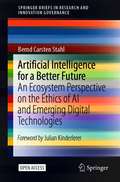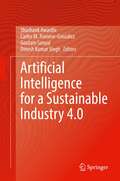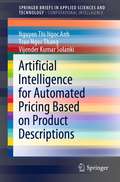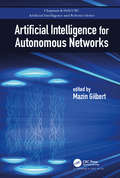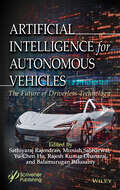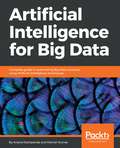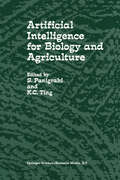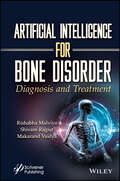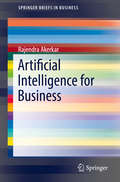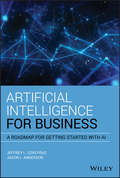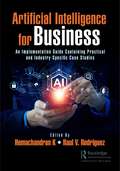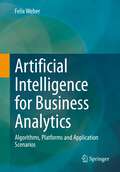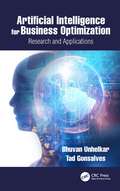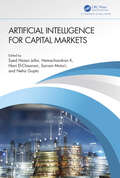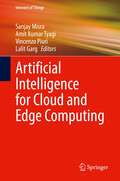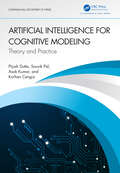- Table View
- List View
Artificial Intelligence, Expert Systems & Symbolic Computing
by E. N. Houstis J. R. RiceThis volume contains papers in the areas of artificial intelligence, expert systems, symbolic computing and applications to scientific computing. Together, they provide an excellent overview of the dynamic state of these closely related fields. They reveal a future where scientific computation will increasingly involve symbolic and artificial intelligence tools as these software systems become more sophisticated; also a future where systems of computational science and engineering will be problem solving environments created with components from numerical analysis, computational geometry, symbolic computing and artificial intelligence.
Artificial Intelligence for 6G
by Haesik KimThis textbook introduces Artificial Intelligence (AI) techniques for wireless communications and networks, helping readers to find solutions for communications and network problems using AI. Artificial Intelligence for 6G introduces, in a step-by-step manner, AI techniques such as: unsupervised learning;supervised learning;reinforcement learning; anddeep learning. It explains how these techniques can be used for wireless communications and network systems, particularly in designing and optimizing 6G networks. This book is at the forefront of 6G research, and will be of interest internationally, to graduate students, academics, engineers, and developers who are focused on future development of network systems and mobile communications.
Artificial Intelligence for a Better Future: An Ecosystem Perspective on the Ethics of AI and Emerging Digital Technologies (SpringerBriefs in Research and Innovation Governance)
by Bernd Carsten StahlThis open access book proposes a novel approach to Artificial Intelligence (AI) ethics. AI offers many advantages: better and faster medical diagnoses, improved business processes and efficiency, and the automation of boring work. But undesirable and ethically problematic consequences are possible too: biases and discrimination, breaches of privacy and security, and societal distortions such as unemployment, economic exploitation and weakened democratic processes. There is even a prospect, ultimately, of super-intelligent machines replacing humans. The key question, then, is: how can we benefit from AI while addressing its ethical problems?This book presents an innovative answer to the question by presenting a different perspective on AI and its ethical consequences. Instead of looking at individual AI techniques, applications or ethical issues, we can understand AI as a system of ecosystems, consisting of numerous interdependent technologies, applications and stakeholders. Developing this idea, the book explores how AI ecosystems can be shaped to foster human flourishing. Drawing on rich empirical insights and detailed conceptual analysis, it suggests practical measures to ensure that AI is used to make the world a better place.
Artificial Intelligence for a Sustainable Industry 4.0
by Shashank Awasthi Carlos M. Travieso-González Goutam Sanyal Dinesh Kumar SinghThis book outlines the recent advancements in the field of artificial intelligence (AI) and addresses how useful it is in achieving truly sustainable solutions. The book also serves as a useful reference literature in developing sustainable engineering solutions to various social and techno-commercial issues of global significance. This book is organized into two sections: section 1 is focused on fundamentals and principles of AI to lay the groundwork for the second section. Section 2 explores the sustainable engineering solutions development using AI, which addresses challenges in various computing techniques and opportunities in engineering design for sustainable development using IoT/AI and smart cities. Applications include waste minimization, re-manufacturing, reuse and recycling technologies using IoT/AI, Industry 4.0, intelligent and smart grid systems, energy conservation using technology, and robotic process automation (RPA). The book is ideal for the engineers, researchers and students interested in how AI can aid in sustainable development applications.
Artificial Intelligence for Automated Pricing Based on Product Descriptions (SpringerBriefs in Applied Sciences and Technology)
by Nguyen Thi Anh Tran Ngoc Thang Vijender Kumar SolankiThis book highlights artificial intelligence algorithms used in implementation of automated pricing. It presents the process for building automated pricing models from crawl data, preprocessed data to implement models, and their applications. The book also focuses on machine learning and deep learning methods for pricing, including from regression methods to hybrid and ensemble methods. The computational experiments are presented to illustrate the pricing processes and models.
Artificial Intelligence for Autonomous Networks (Chapman & Hall/CRC Artificial Intelligence and Robotics Series)
by Mazin GilbertArtificial Intelligence for Autonomous Networks introduces the autonomous network by juxtaposing two unique technologies and communities: Networking and AI. The book reviews the technologies behind AI and software-defined network/network function virtualization, highlighting the exciting opportunities to integrate those two worlds. Outlining the new frontiers for autonomous networks, this book highlights their impact and benefits to consumers and enterprise customers. It also explores the potential of the autonomous network for transforming network operation, cyber security, enterprise services, 5G and IoT, infrastructure monitoring and traffic optimization, and finally, customer experience and care. With contributions from leading experts, this book will provide an invaluable resource for network engineers, software engineers, artificial intelligence, and machine learning researchers.
Artificial Intelligence for Autonomous Networks (Chapman & Hall/CRC Artificial Intelligence and Robotics Series)
by Mazin GilbertArtificial Intelligence for Autonomous Networks introduces the autonomous network by juxtaposing two unique technologies and communities: Networking and AI. The book reviews the technologies behind AI and software-defined network/network function virtualization, highlighting the exciting opportunities to integrate those two worlds. Outlining the new frontiers for autonomous networks, this book highlights their impact and benefits to consumers and enterprise customers. It also explores the potential of the autonomous network for transforming network operation, cyber security, enterprise services, 5G and IoT, infrastructure monitoring and traffic optimization, and finally, customer experience and care. With contributions from leading experts, this book will provide an invaluable resource for network engineers, software engineers, artificial intelligence, and machine learning researchers.
Artificial Intelligence for Autonomous Vehicles: The Future of Driverless Technology (Advances in Data Engineering and Machine Learning)
by Sathiyaraj Rajendran Munish Sabharwal Yu-Chen Hu Rajesh Kumar Dhanaraj Balamurugan BalusamyWith the advent of advanced technologies in AI, driverless vehicles have elevated curiosity among various sectors of society. The automotive industry is in a technological boom with autonomous vehicle concepts. Autonomous driving is one of the crucial application areas of Artificial Intelligence (AI). Autonomous vehicles are armed with sensors, radars, and cameras. This made driverless technology possible in many parts of the world. In short, our traditional vehicle driving may swing to driverless technology. Many researchers are trying to come out with novel AI algorithms that are capable of handling driverless technology. The current existing algorithms are not able to support and elevate the concept of autonomous vehicles. This addresses the necessity of novel methods and tools focused to design and develop frameworks for autonomous vehicles. There is a great demand for energy-efficient solutions for managing the data collected with the help of sensors. These operations are exclusively focused on non-traditional programming approaches and depend on machine learning techniques, which are part of AI. There are multiple issues that AI needs to resolve for us to achieve a reliable and safe driverless technology. The purpose of this book is to find effective solutions to make autonomous vehicles a reality, presenting their challenges and endeavors. The major contribution of this book is to provide a bundle of AI solutions for driverless technology that can offer a safe, clean, and more convenient riskless mode of transportation.
Artificial Intelligence for Autonomous Vehicles: The Future of Driverless Technology (Advances in Data Engineering and Machine Learning)
by Sathiyaraj Rajendran Munish Sabharwal Yu-Chen Hu Rajesh Kumar Dhanaraj Balamurugan BalusamyWith the advent of advanced technologies in AI, driverless vehicles have elevated curiosity among various sectors of society. The automotive industry is in a technological boom with autonomous vehicle concepts. Autonomous driving is one of the crucial application areas of Artificial Intelligence (AI). Autonomous vehicles are armed with sensors, radars, and cameras. This made driverless technology possible in many parts of the world. In short, our traditional vehicle driving may swing to driverless technology. Many researchers are trying to come out with novel AI algorithms that are capable of handling driverless technology. The current existing algorithms are not able to support and elevate the concept of autonomous vehicles. This addresses the necessity of novel methods and tools focused to design and develop frameworks for autonomous vehicles. There is a great demand for energy-efficient solutions for managing the data collected with the help of sensors. These operations are exclusively focused on non-traditional programming approaches and depend on machine learning techniques, which are part of AI. There are multiple issues that AI needs to resolve for us to achieve a reliable and safe driverless technology. The purpose of this book is to find effective solutions to make autonomous vehicles a reality, presenting their challenges and endeavors. The major contribution of this book is to provide a bundle of AI solutions for driverless technology that can offer a safe, clean, and more convenient riskless mode of transportation.
Artificial Intelligence for Big Data: Complete Guide To Automating Big Data Solutions Using Artificial Intelligence Techniques
by Anand DeshpandeCreate smart systems to extract intelligent insights for decision making. You will learn about widely used Artificial Intelligence techniques for carrying out solutions in a production-ready environment. You'll explore advanced topics such as clustering, symbolic and sub-symbolic information representation, and many more.
Artificial Intelligence for Bone Disorder: Diagnosis and Treatment
by Rishabha Malviya Shivam Rajput Makarand VaidyaARTIFICIAL INTELLIGENCE FOR BONE DISORDER The authors have produced an invaluable resource that connects the fields of AI and bone treatment by providing essential insights into the current state and future of AI in bone condition diagnosis and therapy, as well as a methodical examination of machine learning algorithms, deep learning approaches, and their real-world uses. The book explores the use of artificial intelligence (AI) in the diagnosis and treatment of various bone illnesses. The integration of AI approaches in the fields of orthopedics, radiography, tissue engineering, and other areas related to bone are discussed in detail. It covers tissue engineering methods for bone regeneration and investigates the use of AI tools in this area, emphasizing the value of deep learning and how to use AI in tissue engineering efficiently. The book also covers diagnostic and prognostic uses of AI in orthopedics, such as the diagnosis of disorders involving the hip and knee as well as prognoses for therapies. Chapters also look at MRI, trabecular biomechanical strength, and other methods for diagnosing osteoporosis. Other issues the book examines include several uses of AI in pediatric orthopedics, 3D modeling, digital X-ray radiogrammetry, convolutional neural networks for customized care, and digital tomography. With information on the most recent developments and potential future applications, each chapter of the book advances our understanding of how AI might be used to diagnose and treat bone problems. Audience This book will serve as a guide for orthopedic experts, biomedical engineers, faculty members, research scholars, IT specialists, healthcare workers, and hospital administrators.
Artificial Intelligence for Bone Disorder: Diagnosis and Treatment
by Rishabha Malviya Shivam Rajput Makarand VaidyaARTIFICIAL INTELLIGENCE FOR BONE DISORDER The authors have produced an invaluable resource that connects the fields of AI and bone treatment by providing essential insights into the current state and future of AI in bone condition diagnosis and therapy, as well as a methodical examination of machine learning algorithms, deep learning approaches, and their real-world uses. The book explores the use of artificial intelligence (AI) in the diagnosis and treatment of various bone illnesses. The integration of AI approaches in the fields of orthopedics, radiography, tissue engineering, and other areas related to bone are discussed in detail. It covers tissue engineering methods for bone regeneration and investigates the use of AI tools in this area, emphasizing the value of deep learning and how to use AI in tissue engineering efficiently. The book also covers diagnostic and prognostic uses of AI in orthopedics, such as the diagnosis of disorders involving the hip and knee as well as prognoses for therapies. Chapters also look at MRI, trabecular biomechanical strength, and other methods for diagnosing osteoporosis. Other issues the book examines include several uses of AI in pediatric orthopedics, 3D modeling, digital X-ray radiogrammetry, convolutional neural networks for customized care, and digital tomography. With information on the most recent developments and potential future applications, each chapter of the book advances our understanding of how AI might be used to diagnose and treat bone problems. Audience This book will serve as a guide for orthopedic experts, biomedical engineers, faculty members, research scholars, IT specialists, healthcare workers, and hospital administrators.
Artificial Intelligence for Business (SpringerBriefs in Business)
by Rajendra AkerkarThis book offers a practical guide to artificial intelligence (AI) techniques that are used in business. The book does not focus on AI models and algorithms, but instead provides an overview of the most popular and frequently used models in business. This allows the book to easily explain AI paradigms and concepts for business students and executives. Artificial Intelligence for Business is divided into six chapters. Chapter 1 begins with a brief introduction to AI and describes its relationship with machine learning, data science and big data analytics. Chapter 2 presents core machine learning workflow and the most effective machine learning techniques. Chapter 3 deals with deep learning, a popular technique for developing AI applications. Chapter 4 introduces recommendation engines for business and covers how to use them to be more competitive. Chapter 5 features natural language processing (NLP) for sentiment analysis focused on emotions. With the help of sentiment analysis, businesses can understand their customers better to improve their experience, which will help the businesses change their market position. Chapter 6 states potential business prospects of AI and the benefits that companies can realize by implementing AI in their processes.
Artificial Intelligence for Business: A Roadmap for Getting Started with AI
by Jason L. Anderson Jeffrey L. CoveyducArtificial Intelligence for Business: A Roadmap for Getting Started with AI will provide the reader with an easy to understand roadmap for how to take an organization through the adoption of AI technology. It will first help with the identification of which business problems and opportunities are right for AI and how to prioritize them to maximize the likelihood of success. Specific methodologies are introduced to help with finding critical training data within an organization and how to fill data gaps if they exist. With data in hand, a scoped prototype can be built to limit risk and provide tangible value to the organization as a whole to justify further investment. Finally, a production level AI system can be developed with best practices to ensure quality with not only the application code, but also the AI models. Finally, with this particular AI adoption journey at an end, the authors will show that there is additional value to be gained by iterating on this AI adoption lifecycle and improving other parts of the organization.
Artificial Intelligence for Business: A Roadmap for Getting Started with AI
by Jason L. Anderson Jeffrey L. CoveyducArtificial Intelligence for Business: A Roadmap for Getting Started with AI will provide the reader with an easy to understand roadmap for how to take an organization through the adoption of AI technology. It will first help with the identification of which business problems and opportunities are right for AI and how to prioritize them to maximize the likelihood of success. Specific methodologies are introduced to help with finding critical training data within an organization and how to fill data gaps if they exist. With data in hand, a scoped prototype can be built to limit risk and provide tangible value to the organization as a whole to justify further investment. Finally, a production level AI system can be developed with best practices to ensure quality with not only the application code, but also the AI models. Finally, with this particular AI adoption journey at an end, the authors will show that there is additional value to be gained by iterating on this AI adoption lifecycle and improving other parts of the organization.
Artificial Intelligence for Business: An Implementation Guide Containing Practical and Industry-Specific Case Studies
by K Hemachandran Raul V. RodriguezArtificial intelligence (AI) is transforming the business world at an unprecedented pace. From automating mundane tasks to predicting consumer behaviour, AI is changing the way businesses operate across all sectors. This book is an exploration of AI in business applications, highlighting the diverse range of ways in which AI is being used across different industries. The book begins with an overview of AI in business and its impact on the workforce. It then explores the role of AI in marketing, advertising, and tourism. The use of AI in personalized recommendations and chatbots is discussed in detail. The book then moves on to examine how AI is changing the retail industry, improving supply chain management, and enhancing the customer experience. The media and entertainment industry is also examined, with a focus on how AI is being used to personalize content and improve the user experience. The book also explores the use of AI in human resources, insurance, legal, and finance. The impact of AI on talent identification, recruitment, underwriting, document analysis, and financial forecasting is discussed in detail. In the healthcare and sports industries, AI is transforming the way we approach diagnosis, treatment, and training. The book examines how AI is being used to analyse medical images, develop personalized treatment plans, and improve patient outcomes. The use of AI in sports performance analysis is also discussed in detail. Finally, the book explores the use of AI in agriculture, energy, education, and the public sector. The potential of AI to optimize crop yields, reduce energy consumption, and improve the quality of education is discussed in detail. The book also examines how AI is being used to improve public services, such as transportation and emergency services. This book is a valuable resource for academics, researchers, professionals, and policymakers who are interested in understanding the potential of AI in the business world. The contributions from leading experts and researchers provide a comprehensive overview of AI in business applications, and how it is transforming different sectors. The book also examines the ethical dilemmas that arise from the use of AI in business, such as the impact on privacy and data security, and the potential for bias in AI algorithms. It provides valuable insights into how businesses can ensure that the use of AI is ethical and responsible. In conclusion, this book is a must-read for anyone interested in the potential of AI in the business world. It provides a comprehensive overview of AI in business applications and how it is transforming different sectors. The book examines the ethical dilemmas that arise from the use of AI in business, providing valuable insights into how businesses can ensure that the use of AI is ethical and responsible. We hope that readers will find this book informative and thought-provoking.
Artificial Intelligence for Business: An Implementation Guide Containing Practical and Industry-Specific Case Studies
Artificial intelligence (AI) is transforming the business world at an unprecedented pace. From automating mundane tasks to predicting consumer behaviour, AI is changing the way businesses operate across all sectors. This book is an exploration of AI in business applications, highlighting the diverse range of ways in which AI is being used across different industries. The book begins with an overview of AI in business and its impact on the workforce. It then explores the role of AI in marketing, advertising, and tourism. The use of AI in personalized recommendations and chatbots is discussed in detail. The book then moves on to examine how AI is changing the retail industry, improving supply chain management, and enhancing the customer experience. The media and entertainment industry is also examined, with a focus on how AI is being used to personalize content and improve the user experience. The book also explores the use of AI in human resources, insurance, legal, and finance. The impact of AI on talent identification, recruitment, underwriting, document analysis, and financial forecasting is discussed in detail. In the healthcare and sports industries, AI is transforming the way we approach diagnosis, treatment, and training. The book examines how AI is being used to analyse medical images, develop personalized treatment plans, and improve patient outcomes. The use of AI in sports performance analysis is also discussed in detail. Finally, the book explores the use of AI in agriculture, energy, education, and the public sector. The potential of AI to optimize crop yields, reduce energy consumption, and improve the quality of education is discussed in detail. The book also examines how AI is being used to improve public services, such as transportation and emergency services. This book is a valuable resource for academics, researchers, professionals, and policymakers who are interested in understanding the potential of AI in the business world. The contributions from leading experts and researchers provide a comprehensive overview of AI in business applications, and how it is transforming different sectors. The book also examines the ethical dilemmas that arise from the use of AI in business, such as the impact on privacy and data security, and the potential for bias in AI algorithms. It provides valuable insights into how businesses can ensure that the use of AI is ethical and responsible. In conclusion, this book is a must-read for anyone interested in the potential of AI in the business world. It provides a comprehensive overview of AI in business applications and how it is transforming different sectors. The book examines the ethical dilemmas that arise from the use of AI in business, providing valuable insights into how businesses can ensure that the use of AI is ethical and responsible. We hope that readers will find this book informative and thought-provoking.
Artificial Intelligence for Business Analytics: Algorithms, Platforms and Application Scenarios
by Felix WeberWhile methods of artificial intelligence (AI) were until a few years ago exclusively a topic of scientific discussions, today they are increasingly finding their way into products of everyday life. At the same time, the amount of data produced and available is growing due to increasing digitalization, the integration of digital measurement and control systems, and automatic exchange between devices (Internet of Things). In the future, the use of business intelligence (BI) and a look into the past will no longer be sufficient for most companies.Instead, business analytics, i.e., predictive and predictive analyses and automated decisions, will be needed to stay competitive in the future. The use of growing amounts of data is a significant challenge and one of the most important areas of data analysis is represented by artificial intelligence methods.This book provides a concise introduction to the essential aspects of using artificial intelligence methods for business analytics, presents machine learning and the most important algorithms in a comprehensible form using the business analytics technology framework, and shows application scenarios from various industries. In addition, it provides the Business Analytics Model for Artificial Intelligence, a reference procedure model for structuring BA and AI projects in the company.This book is a translation of the original German 1st edition Künstliche Intelligenz für Business Analytics by Felix Weber, published by Springer Fachmedien Wiesbaden GmbH, part of Springer Nature in 2020. The translation was done with the help of artificial intelligence (machine translation by the service DeepL.com). A subsequent human revision was done primarily in terms of content, so that the book will read stylistically differently from a conventional translation. Springer Nature works continuously to further the development of tools for the production of books and on the related technologies to support the authors.
Artificial Intelligence for Business Optimization: Research and Applications
by Bhuvan Unhelkar Tad GonsalvesThis is primarily a business book that discusses the research and associated practical application of artificial intelligence (AI) and machine learning (ML) in order to achieve business optimization (BO). AI comprises a wide range of technologies, databases, algorithms, and devices. This book aims for a holistic approach to AI by focusing on developing business strategies that will not only automate but also optimize business functions, processes, and people’s behaviors. Artificial Intelligence for Business Optimization: Research and Applications explores AI and ML from a business viewpoint with the key purpose of enhancing customer value. It applies research methods and fundamentals from a practitioner’s viewpoint and incorporates discussions around risks and changes associated with the utilization of AI in business. Furthermore, governance risks, privacy, and security are also addressed in this book to ensure compliance with AI/ML applications. Readers should find direct and practical applications of the discussions in this book quite useful in their work environment. Researchers will find many ideas to further explore the applications of AI to business.
Artificial Intelligence for Business Optimization: Research and Applications
by Bhuvan Unhelkar Tad GonsalvesThis is primarily a business book that discusses the research and associated practical application of artificial intelligence (AI) and machine learning (ML) in order to achieve business optimization (BO). AI comprises a wide range of technologies, databases, algorithms, and devices. This book aims for a holistic approach to AI by focusing on developing business strategies that will not only automate but also optimize business functions, processes, and people’s behaviors. Artificial Intelligence for Business Optimization: Research and Applications explores AI and ML from a business viewpoint with the key purpose of enhancing customer value. It applies research methods and fundamentals from a practitioner’s viewpoint and incorporates discussions around risks and changes associated with the utilization of AI in business. Furthermore, governance risks, privacy, and security are also addressed in this book to ensure compliance with AI/ML applications. Readers should find direct and practical applications of the discussions in this book quite useful in their work environment. Researchers will find many ideas to further explore the applications of AI to business.
Artificial Intelligence for Capital Markets
by Syed Hasan Jafar K Hemachandran Hani El-Chaarani Sairam Moturi Neha GuptaArtificial Intelligence for Capital Market throws light on the application of AI/ML techniques in the financial capital markets. This book discusses the challenges posed by the AI/ML techniques as these are prone to "black box" syndrome. The complexity of understanding the underlying dynamics for results generated by these methods is one of the major concerns which is highlighted in this book. Features: Showcases artificial intelligence in finance service industry Explains credit and risk analysis Elaborates on cryptocurrencies and blockchain technology Focuses on the optimal choice of asset pricing model Introduces testing of market efficiency and forecasting in the Indian stock market This book serves as a reference book for academicians, industry professionals, traders, finance managers and stock brokers. It may also be used as textbook for graduate level courses in financial services and financial analytics.
Artificial Intelligence for Capital Markets
by Syed Hasan Jafar Hemachandran K Hani El-Chaarani Sairam Moturi Neha GuptaArtificial Intelligence for Capital Market throws light on the application of AI/ML techniques in the financial capital markets. This book discusses the challenges posed by the AI/ML techniques as these are prone to "black box" syndrome. The complexity of understanding the underlying dynamics for results generated by these methods is one of the major concerns which is highlighted in this book. Features: Showcases artificial intelligence in finance service industry Explains credit and risk analysis Elaborates on cryptocurrencies and blockchain technology Focuses on the optimal choice of asset pricing model Introduces testing of market efficiency and forecasting in the Indian stock market This book serves as a reference book for academicians, industry professionals, traders, finance managers and stock brokers. It may also be used as textbook for graduate level courses in financial services and financial analytics.
Artificial Intelligence for Cloud and Edge Computing (Internet of Things)
by Vincenzo Piuri Sanjay Misra Lalit Garg Amit Kumar TyagiThis book discusses the future possibilities of AI with cloud computing and edge computing. The main goal of this book is to conduct analyses, implementation and discussion of many tools (of artificial intelligence, machine learning and deep learning and cloud computing, fog computing, and edge computing including concepts of cyber security) for understanding integration of these technologies. With this book, readers can quickly get an overview of these emerging topics and get many ideas of the future of AI with cloud, edge, and in many other areas. Topics include machine and deep learning techniques for Internet of Things based cloud systems; security, privacy and trust issues in AI based cloud and IoT based cloud systems; AI for smart data storage in cloud-based IoT; blockchain based solutions for AI based cloud and IoT based cloud systems.This book is relevent to researchers, academics, students, and professionals.
Artificial Intelligence for Cognitive Modeling: Theory and Practice (Chapman & Hall/CRC Internet of Things)
by Pijush Dutta Souvik Pal Asok Kumar Korhan CengizThis book is written in a clear and thorough way to cover both the traditional and modern uses of artificial intelligence and soft computing. It gives an in-depth look at mathematical models, algorithms, and real-world problems that are hard to solve in MATLAB. The book is intended to provide a broad and in-depth understanding of fuzzy logic controllers, genetic algorithms, neural networks, and hybrid techniques such as ANFIS and the GA-ANN model. Features A detailed description of basic intelligent techniques (fuzzy logic, genetic algorithm and neural network using MATLAB) A detailed description of the hybrid intelligent technique called the adaptive fuzzy inference technique(ANFIS) Formulation of the nonlinear model like analysis of ANOVA and response surface methodology Variety of solved problem on ANOVA and RSM Case studies of above mentioned intelligent techniques on the different process control systems This book can be used as a handbook and a guide for students of all engineering disciplines, operational research areas, computer applications, and for various professionals who work in the optimization area.
